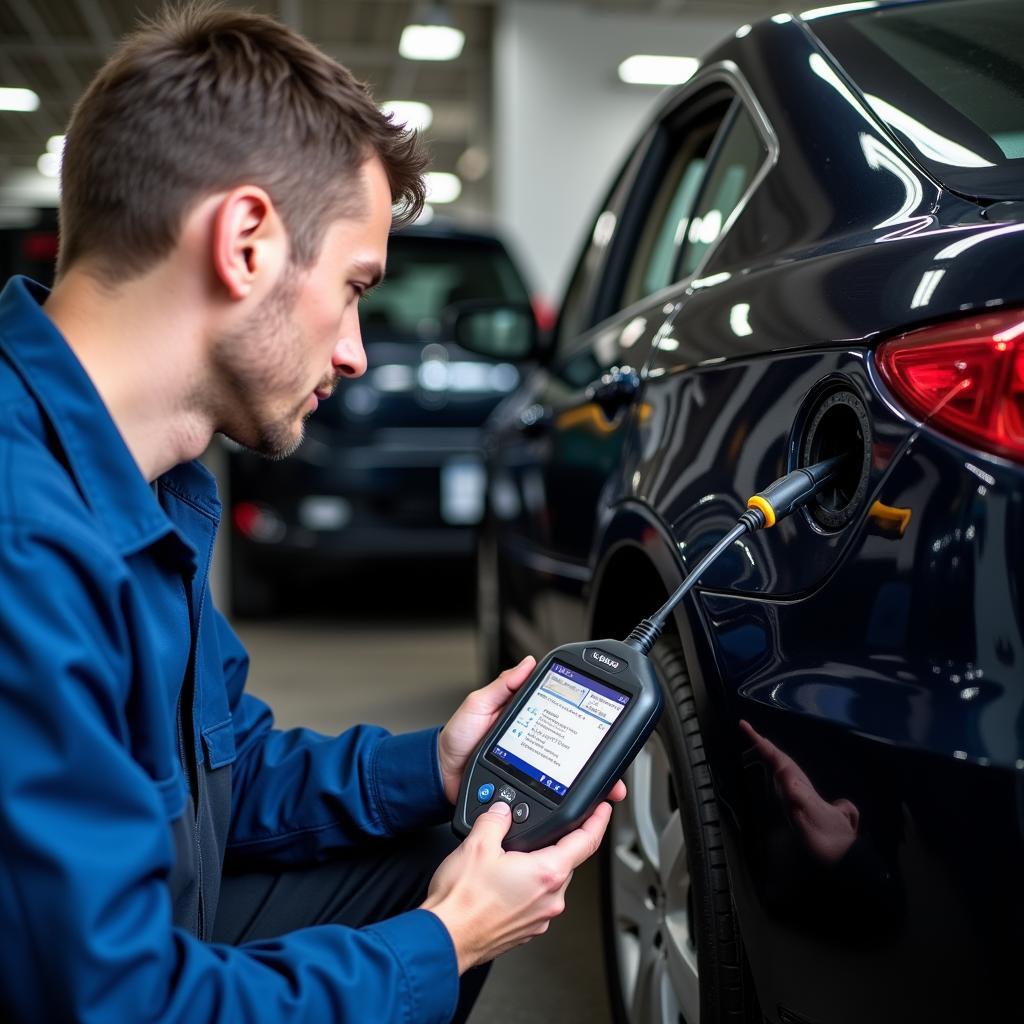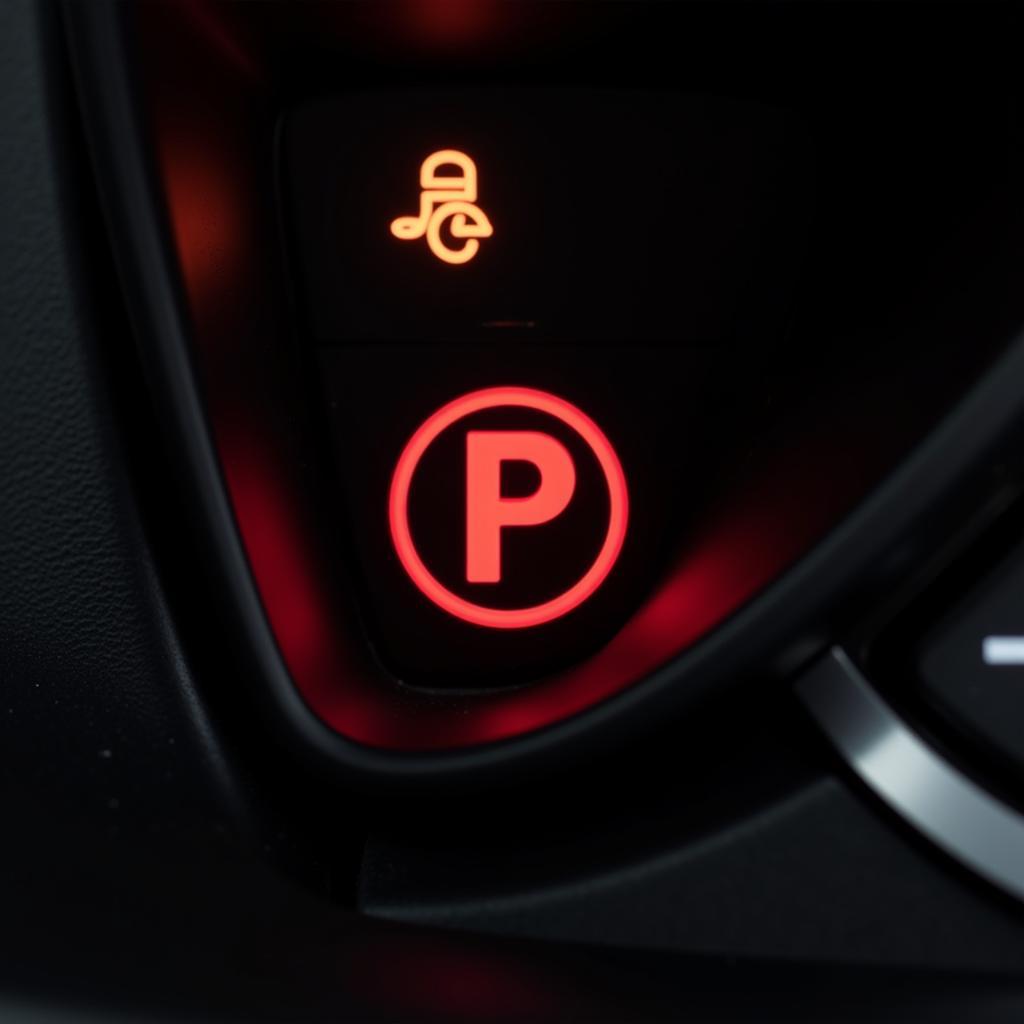A flashing or illuminated seat belt warning light is a common issue that can lead to MOT failure. While a simple reminder to buckle up in most cases, a persistent warning light even when buckled signifies a fault within the seat belt system. This article delves into the common causes of a seat belt warning light MOT failure and provides insights on diagnosis, repair, and preventative measures.
Understanding the Seat Belt Warning System
Modern vehicles employ a Seat Belt Reminder System (SBRS) to enhance safety. This system utilizes sensors to detect the presence of a fastened seat belt. When the ignition is on and the seat belt remains unfastened, the SBRS activates an audible chime and a visual warning light on the dashboard. The system aims to ensure both driver and passengers are securely buckled, minimizing risks associated with collisions or sudden stops.
Common Causes of Seat Belt Warning Light MOT Failure
 Seat belt warning light on car dashboard
Seat belt warning light on car dashboard
Several factors can trigger a seat belt warning light to illuminate, potentially leading to an MOT failure:
- Faulty Seat Belt Buckle/Latch: The buckle, where you connect the seat belt, houses a sensor detecting the connection. Over time, this sensor can wear out, become damaged, or get clogged with dirt and debris, leading to a false signal.
- Wiring Issues: The wiring harness connecting the seat belt buckle sensor to the vehicle’s electrical system can fray, corrode, or become disconnected. This disruption in the circuit can trigger a continuous warning light.
- Seat Belt Pretensioner Fault: Modern vehicles are equipped with seat belt pretensioners that tighten the seat belt in the event of a collision. These pretensioners have sensors that, if faulty, can trigger the warning light.
- Faulty Occupant Detection System: Some vehicles incorporate an Occupant Detection System (ODS) to detect the presence of a passenger and deactivate the airbag if the seat is empty. A malfunctioning ODS sensor can also illuminate the seat belt warning light.
- Software Glitches: Like any electronic system, the SBRS relies on software. Occasional glitches or errors in the software can lead to false readings and trigger the warning light.
Diagnosing the Problem
 Mechanic using OBD scanner to diagnose car problem
Mechanic using OBD scanner to diagnose car problem
Accurately diagnosing the root cause of a seat belt warning light issue often requires specialist diagnostic tools. Here’s a general approach:
- Visual Inspection: Begin by visually inspecting the seat belt buckle, wiring, and connections for any visible signs of damage, wear, or loose connections.
- OBD-II Scanner: Utilize an OBD-II scanner to read the fault codes stored in the vehicle’s computer. These codes provide valuable insights into the specific area of the seat belt system that is malfunctioning.
- Specialized Software: Advanced diagnostic software specifically designed for automotive systems can be used to run more comprehensive tests, monitor sensor data, and pinpoint the root cause of the problem.
“When dealing with safety-critical systems like seat belts, it’s crucial to have the right expertise and equipment,” says John Miller, a veteran automotive electrician. “Attempting DIY repairs without proper knowledge can be risky and potentially exacerbate the problem.”
Solutions and Repairs
Depending on the diagnosed fault, resolving a seat belt warning light issue can range from simple fixes to more complex repairs:
- Cleaning and Reconnection: For minor issues like a dirty buckle sensor, cleaning the connection points or reconnecting loose wires might suffice.
- Component Replacement: Faulty components such as the buckle, pretensioner, or ODS sensor may require replacement with new ones.
- Software Update or Reset: In cases of software glitches, a software update or reset using specialized equipment can often rectify the problem.
- Wiring Harness Repair: Damaged wiring harnesses may need to be repaired or replaced.
Preventative Measures
While some causes are unavoidable due to wear and tear, proactive measures can help prevent seat belt warning light issues:
- Regular Inspection: Periodically inspect your seat belt buckles and belts for any signs of wear, damage, or fraying.
- Careful Handling: Avoid bending the buckle excessively or spilling liquids that could damage the sensors.
- Timely Servicing: Adhere to the manufacturer’s recommended service intervals for your vehicle, ensuring that the seat belt system is inspected and maintained.
Conclusion
A seat belt warning light, though seemingly minor, can indicate a potentially serious issue with your vehicle’s safety system and lead to MOT failure. Addressing this issue promptly through proper diagnosis and repair is crucial to ensure the safety of you and your passengers. Remember, regular maintenance and a proactive approach to car care can go a long way in preventing such issues and promoting overall vehicle safety.
FAQs
1. Can I drive my car with the seat belt warning light on?
While driving with the seat belt warning light on might be possible, it’s strongly discouraged. The warning light signifies a potential fault in your seat belt system, compromising your safety in case of an accident.
2. How much does it cost to fix a seat belt warning light?
The cost of repair varies depending on the underlying cause and the complexity of the fix. A simple cleaning or reset could be inexpensive, while component replacement can be more costly.
3. Can I reset the seat belt warning light myself?
While some online resources might offer DIY reset methods, it’s advisable to leave this to professionals. Incorrect procedures can potentially damage your vehicle’s electrical system.
4. Is a seat belt warning light a common MOT failure?
Yes, a malfunctioning seat belt warning light can result in MOT failure as it indicates a potential safety risk.
5. How often should I get my seat belt system checked?
It’s recommended to have your seat belt system inspected by a qualified mechanic at least once a year or as part of your vehicle’s regular service.
This concludes our comprehensive guide to understanding and addressing seat belt warning light MOT failures. Remember, prioritizing your safety and the safety of your passengers should always be paramount.


